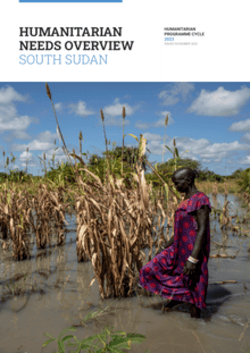Summary
Context, shocks and impact of the crisis

Eleven years after independence and four years after the signing of the revitalized peace agreement, people in South Sudan continue to face deteriorating humanitarian conditions. Their situation is worsened by endemic violence, conflict, access constraints and operational interference, public health challenges such as measles and cholera outbreaks and climatic shocks resulting in extraordinary flooding and localized drought. These in turn have a severe impact on people’s livelihoods, hamper access to education and water, sanitation and hygiene and health services. Protection concerns remain high, especially for women and girls. People affected by violence have limited access to formal justice as well as restriction in their movement and access to basic needs such as food.
An estimated 2.2 million people are displaced in the country since 2013 and more than 2.3 million South Sudanese refugees are hosted in the neighbouring countries. At least 148,000 returnees from abroad remain displaced within the country, unable to reach their homes. Continued conflict and instability in South Sudan, combined with flooding, have resulted in largescale internal and cross-border displacement. Above normal rainfall for the fourth consecutive year in 2022 led to prolonged flooding, which affected areas that had not flooded in previous years. Since July 2022, an estimated 1 million people were affected by severe flooding in 36 counties across South Sudan and in the southern part of the Abyei Administrative Area. People in Northern Bahr el Ghazal, Warrap, Unity and Western Equatoria states are the worst affected and 80 per cent of those affected were from Jonglei, Unity and Upper Nile states. People were forcibly displaced repeatedly due to multiple compounding shocks, both in areas of displacement and return.
The humanitarian community in South Sudan estimates that 9.4 million people will be in need of humanitarian assistance in 2023, a staggering 76 per cent of South Sudan's population, increased by 500,000 people from 2022. At least 148,000 returnees from abroad remained displaced within the country, unable to reach their homes.
Scope of analysis
The 2023 South Sudan Humanitarian Needs Overview (HNO) focuses on the humanitarian needs of the internally displaced persons (IDPs), returnees and vulnerable host communities/non-displaced people in South Sudan and in the Abyei Administrative Area. The current analysis also includes vulnerable sub-groups, including female-headed households and people with disabilities (PWD), whose vulnerabilities have been aggravated by the ongoing conflict, flooding and economic depreciation.
Given the inter-connected nature of the shocks and risks in South Sudan, their impacts on people’s situation into and beyond 2023 remain uncertain. The 2022 Inter-Sector Needs Assessment (ISNA) conducted in 75 out of 78 counties across South Sudan and the Abyei Administrative Area was used to understand and analyse the evolution of people’s humanitarian needs and to identify the impact of shocks on the vulnerable population groups. Potential risks that could affect the humanitarian needs of the most vulnerable communities are outlined in section 2.1 of this analysis. A most likely scenario for 2023 is also outlined in section 2.1, with support from the United Nations Disaster Risk Reduction (UNDRR).
Humanitarian conditions, severity and people in need
The deterioration of people’s physical and mental well-being, living standards and coping mechanisms is expected to leave 9.4 million people in need of humanitarian assistance in 2023, higher than the 8.9 million people in need of humanitarian assistance in 2022. This increase is largely driven by compounded shocks triggered by continued conflict, widespread flooding, deepening food insecurity, inflation, high food prices and lack of access to basic services.
The inter-sectoral analysis conducted using cluster people in need (PiN) revealed that there are needs in every county of the country. Of the 9.4 million people in need, an estimated 56,325 people will experience catastrophic need in Panyikang county. Moreover, there will be 7.6 million people experiencing extreme need in 66 out of 78 counties and 1.7 million people in severe need in 10 out of 78 counties. Upper Nile and Western Equatoria States will contain the highest number of counties in critical need. In the Abyei Administrative Area, 212,000 people will be in extreme need of humanitarian assistance.
The projected 9.4 million people in need for 2023 include 1.9 million IDPs, 1.4 million returnees, 5.8 million host community/non-displaced people and 337,000 refugees. Among them, there are 2.2 million women and 4.9 million children, including 2.4 million girls and 2.5 million boys. Nearly 15 per cent of the total people in need are PWD.
Covariate climatic, conflict and economic shocks as well as other household-level stressors, like gender-based violence (GBV) and poor WASH services, are some of the key drivers of humanitarian needs in South Sudan. The cumulative impact of recurrent flooding has contributed to the destruction of, and damage to water facilities, increasing the likelihood of water-borne diseases and intensifying the existing vulnerabilities of the affected people, which include high poverty rates, widespread displacement and limited access to basic services such as health, nutrition and education.
More people are projected to experience severe food insecurity in 2023. Between December 2022 and March 2023, an estimated 6.31 million people are expected to face crisis levels under the Integrated Food Security Phase Classification (IPC) Phase 3 and 33,000 people are estimated to face catastrophic levels under IPC Phase 5 of acute food insecurity. Global Acute Malnutrition (GAM) prevalence is projected to be above 15 per cent in 59 counties in 2023.
Women and girls continue to be exposed to risks when carrying out their routine activities to access their basic needs, which are further exacerbated by flooding that limits livelihood opportunities (e.g., collection of firewood and water). Increased cases of sexual violence against, and harassment of, women and girls were also reported, along with the risks of abduction, killings, revenge killings and threats from armed forces. Most verified conflict-related sexual violence cases occurred in Southern Unity State in 2022. Children continue to be at risk of recruitment into local defense groups and other forms of abuse, including abduction and possible trafficking.

